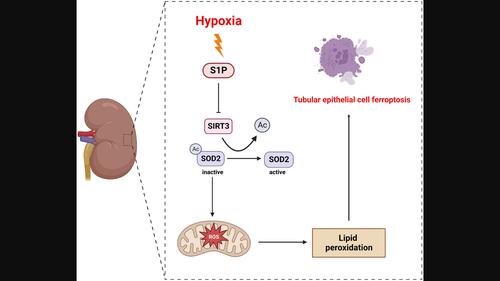当前位置:
X-MOL 学术
›
FEBS Journal
›
论文详情
Our official English website, www.x-mol.net, welcomes your feedback! (Note: you will need to create a separate account there.)
Site 1 protease aggravates acute kidney injury by promoting tubular epithelial cell ferroptosis through SIRT3-SOD2-mtROS signaling
FEBS Journal Pub Date : 2024-01-19 , DOI: 10.1111/febs.17057 Shiying Xie 1, 2 , Wei Zou 1, 2 , Sirui Liu 1, 2 , Qinglan Yang 1, 2 , Tiantian Hu 1, 2 , Wei‐ping Zhu 1, 2 , Hua Tang 3 , Cheng Wang 1, 2
FEBS Journal Pub Date : 2024-01-19 , DOI: 10.1111/febs.17057 Shiying Xie 1, 2 , Wei Zou 1, 2 , Sirui Liu 1, 2 , Qinglan Yang 1, 2 , Tiantian Hu 1, 2 , Wei‐ping Zhu 1, 2 , Hua Tang 3 , Cheng Wang 1, 2
Affiliation

|
Ischemia/reperfusion (I/R)-induced acute kidney injury (AKI) is a common clinical syndrome with high morbidity and mortality. Ferroptosis, a newly discovered form of oxidative cell death, is involved in the pathogenesis of renal I/R injury; however, the underlying mechanism remains to be explored. Here, we reported that site 1 protease (S1P) promotes ischemic kidney injury by regulating ferroptotic cell death of tubular epithelial cells. S1P abundance was measured in hypoxia/reoxygenation (H/R)-treated Boston University mouse proximal tubular (BUMPT) cells and I/R-induced murine kidney tissue. S1P expression in BUMPT cells and kidneys was initially activated by hypoxic stimulation, accompanied by the ferroptotic response. Blocking S1P blunted H/R-induced ferroptotic cell death, which also restored sirtuin 3 (SIRT3) expression and superoxide dismutase 2 (SOD2) activity in BUMPT cells. Next, inhibition of S1P expression restored I/R-suppressed SIRT3 abundance, SOD2 activity and reduced the elevated level of mitochondria reactive oxygen species (mtROS), which attenuated tubular cell ferroptosis and renal I/R injury. In conclusion, S1P promoted renal tubular epithelial cell ferroptosis under I/R status by activating SIRT3-SOD2-mtROS signaling, thereby accelerating kidney injury. Thus, targeting S1P signaling may serve as a promising strategy for I/R kidney injury.
中文翻译:

位点 1 蛋白酶通过 SIRT3-SOD2-mtROS 信号传导促进肾小管上皮细胞铁死亡,从而加重急性肾损伤
缺血/再灌注(I/R)引起的急性肾损伤(AKI)是一种常见的临床综合征,具有高发病率和死亡率。铁死亡是一种新发现的氧化细胞死亡形式,参与肾缺血再灌注损伤的发病机制;然而,其根本机制仍有待探索。在这里,我们报道了位点 1 蛋白酶 (S1P) 通过调节肾小管上皮细胞的铁死亡细胞促进缺血性肾损伤。在缺氧/复氧 (H/R) 处理的波士顿大学小鼠近端肾小管 (BUMPT) 细胞和 I/R 诱导的小鼠肾组织中测量了 S1P 丰度。 BUMPT 细胞和肾脏中的 S1P 表达最初被缺氧刺激激活,并伴有铁死亡反应。阻断S1P可以减弱 H/R 诱导的铁死亡细胞死亡,同时恢复 BUMPT 细胞中沉默调节蛋白 3 (SIRT3) 的表达和超氧化物歧化酶 2 (SOD2) 的活性。接下来,抑制 S1P 表达可恢复 I/R 抑制的 SIRT3 丰度和 SOD2 活性,并降低线粒体活性氧 (mtROS) 水平升高,从而减轻肾小管细胞铁死亡和肾 I/R 损伤。总之,S1P通过激活SIRT3-SOD2-mtROS信号传导促进I/R状态下肾小管上皮细胞铁死亡,从而加速肾损伤。因此,针对 I/R 肾损伤的 S1P 信号传导可能是一种有前景的策略。
更新日期:2024-01-19
中文翻译:

位点 1 蛋白酶通过 SIRT3-SOD2-mtROS 信号传导促进肾小管上皮细胞铁死亡,从而加重急性肾损伤
缺血/再灌注(I/R)引起的急性肾损伤(AKI)是一种常见的临床综合征,具有高发病率和死亡率。铁死亡是一种新发现的氧化细胞死亡形式,参与肾缺血再灌注损伤的发病机制;然而,其根本机制仍有待探索。在这里,我们报道了位点 1 蛋白酶 (S1P) 通过调节肾小管上皮细胞的铁死亡细胞促进缺血性肾损伤。在缺氧/复氧 (H/R) 处理的波士顿大学小鼠近端肾小管 (BUMPT) 细胞和 I/R 诱导的小鼠肾组织中测量了 S1P 丰度。 BUMPT 细胞和肾脏中的 S1P 表达最初被缺氧刺激激活,并伴有铁死亡反应。阻断S1P可以减弱 H/R 诱导的铁死亡细胞死亡,同时恢复 BUMPT 细胞中沉默调节蛋白 3 (SIRT3) 的表达和超氧化物歧化酶 2 (SOD2) 的活性。接下来,抑制 S1P 表达可恢复 I/R 抑制的 SIRT3 丰度和 SOD2 活性,并降低线粒体活性氧 (mtROS) 水平升高,从而减轻肾小管细胞铁死亡和肾 I/R 损伤。总之,S1P通过激活SIRT3-SOD2-mtROS信号传导促进I/R状态下肾小管上皮细胞铁死亡,从而加速肾损伤。因此,针对 I/R 肾损伤的 S1P 信号传导可能是一种有前景的策略。



























 京公网安备 11010802027423号
京公网安备 11010802027423号